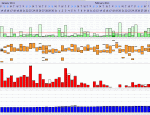bombadil, here are a couple of points that may help.
1. A 5-10% drop of the green line in a few seconds is physiologically impossible and always some kind of artifact. Try this yourself. Hold your breath and watch the oximeter. You'll see that it takes around 1-2 minutes to lower your pO2 below 90%. This is because the air that is trapped in your lungs still contains oxygen that your blood continues to absorb.
2. When the green line is fairly quiet and doesn't fall below, say 92% all night, that's always good. On the contrary, when the line moves around, it may or may not mean something. As others have pointed out, the best use of the oxi. is in conjunction with the report from your xPAP machine. If desats are simultaneous with apneas, you know you are getting valid data, and the degree of desat. is some reflection of the severity of the apnea.
Help interpreting oximetry data
- M.D.Hosehead
- Posts: 742
- Joined: Thu Jun 24, 2010 7:16 pm
- Location: Kansas
Re: Help interpreting oximetry data
_________________
| Mask: Forma Full Face CPAP Mask with Headgear |
| Additional Comments: MaxIPAP 15; MinEPAP 10; Also use Optilife nasal pillow mask with tape |
-
HoseCrusher
- Posts: 2744
- Joined: Tue Oct 12, 2010 6:42 pm
Re: Help interpreting oximetry data
2:11 is an artifact. Notice the gray line segment just before the pulse jump.
4:01 is a little suspect because it occurs reasonably close to the artifact at about 4:00:15. It is not unusual for the pulse increase to lead the O2 desaturation. The desaturated blood has to travel from the heart to your finger tip before it registers on the oximeter.
Keep in mind that variation is breathing occur all the time. If the desaturation doesn't startle you into having an increase in pulse rate, it may just be a sigh or a position change. A startle event that triggers a release of adrenalin is usually accompanied by an increase in pulse rate, and this is what is damaging to your internal organs and damaging to your health.
The goal is to keep O2 levels above 90%, but if they drop below that and there is no significant change in pulse rate, it is just one of those things...
4:34:30 is an artifact. See the gray line segment?
4:50 - 4:55 is very close to the pattern that you see during REM sleep. The pulse increases are minimal even though they seem to sync with O2 changes.
8:57 could be a real event. Still the pulse increase seems more like it is at the high end of normal variation.
9:15 is an artifact. See the gray line segment?
6:17 - 6:23 show that your O2 levels are low, but this is not causing alarm to your heart. Interesting. Not what you want, but it is not the end of the world.
8:04 is similar to the 6:17 - 6:23 data.
Pulse oximetry gives you 2 channels of data to review. Adding flow data from your xPAP machine will give you another channel of data. None of these data sets is perfect and all are subject to interpretation. Still, you can begin to see patterns after you collect data for a few days. When all the data sets point in the same direction, it is pretty clear what is going on. The problem is that sometimes they don't. Then it is time to add an EEG channel to the data set...
4:01 is a little suspect because it occurs reasonably close to the artifact at about 4:00:15. It is not unusual for the pulse increase to lead the O2 desaturation. The desaturated blood has to travel from the heart to your finger tip before it registers on the oximeter.
Keep in mind that variation is breathing occur all the time. If the desaturation doesn't startle you into having an increase in pulse rate, it may just be a sigh or a position change. A startle event that triggers a release of adrenalin is usually accompanied by an increase in pulse rate, and this is what is damaging to your internal organs and damaging to your health.
The goal is to keep O2 levels above 90%, but if they drop below that and there is no significant change in pulse rate, it is just one of those things...
4:34:30 is an artifact. See the gray line segment?
4:50 - 4:55 is very close to the pattern that you see during REM sleep. The pulse increases are minimal even though they seem to sync with O2 changes.
8:57 could be a real event. Still the pulse increase seems more like it is at the high end of normal variation.
9:15 is an artifact. See the gray line segment?
6:17 - 6:23 show that your O2 levels are low, but this is not causing alarm to your heart. Interesting. Not what you want, but it is not the end of the world.
8:04 is similar to the 6:17 - 6:23 data.
Pulse oximetry gives you 2 channels of data to review. Adding flow data from your xPAP machine will give you another channel of data. None of these data sets is perfect and all are subject to interpretation. Still, you can begin to see patterns after you collect data for a few days. When all the data sets point in the same direction, it is pretty clear what is going on. The problem is that sometimes they don't. Then it is time to add an EEG channel to the data set...
_________________
| Mask: Brevida™ Nasal Pillow CPAP Mask with Headgear |
| Additional Comments: Machine is an AirSense 10 AutoSet For Her with Heated Humidifier. |
SpO2 96+% and holding...
-
HoseCrusher
- Posts: 2744
- Joined: Tue Oct 12, 2010 6:42 pm
Re: Help interpreting oximetry data
Keep in mind that sleep breathing is different than breathing while awake. If you take several deep breaths and then hold them, it will take a long time for your O2 levels to drop. This is similar to swimming the length of the pool underwater.
However, sleep breathing is more shallow and more frequent. A sleep breathing rate may be in the 12 - 15 breaths a minute range. If you do that with deep breathing you will hyperventilate. To test an oximeter you need to settle in a restful position, then do your best to duplicate sleep breathing. It takes a little time to find the rhythm, but it is possible. Since obstructions prevent air from going in, you need to exhale, then hold your breath to see how fast the oximeter records an O2 desaturation.
When I do that I find that I have to hold my breath for about 90 seconds to get my O2 levels to drop below 90%. In my case the drop in O2 saturation from 95% down to 88% takes about 15 seconds. During the first 75 seconds the O2 levels are reasonably steady then start a slow decline.
Each body may respond a little differently, so it is best if you can do your own tests and save the data to refer to as you try to interpret the pulse oximeter data.
If your O2 level drops in 1 - 2 seconds, it is an artifact.
However, sleep breathing is more shallow and more frequent. A sleep breathing rate may be in the 12 - 15 breaths a minute range. If you do that with deep breathing you will hyperventilate. To test an oximeter you need to settle in a restful position, then do your best to duplicate sleep breathing. It takes a little time to find the rhythm, but it is possible. Since obstructions prevent air from going in, you need to exhale, then hold your breath to see how fast the oximeter records an O2 desaturation.
When I do that I find that I have to hold my breath for about 90 seconds to get my O2 levels to drop below 90%. In my case the drop in O2 saturation from 95% down to 88% takes about 15 seconds. During the first 75 seconds the O2 levels are reasonably steady then start a slow decline.
Each body may respond a little differently, so it is best if you can do your own tests and save the data to refer to as you try to interpret the pulse oximeter data.
If your O2 level drops in 1 - 2 seconds, it is an artifact.
_________________
| Mask: Brevida™ Nasal Pillow CPAP Mask with Headgear |
| Additional Comments: Machine is an AirSense 10 AutoSet For Her with Heated Humidifier. |
SpO2 96+% and holding...
Re: Help interpreting oximetry data
Thanks again, everyone, for the replies. I'm learning a lot about interpreting oximetry data.
_________________
| Mask: Quattro™ FX Full Face CPAP Mask with Headgear |
| Additional Comments: Contac CMS 50-F oximeter |
- Lizistired
- Posts: 2835
- Joined: Tue Dec 14, 2010 10:47 pm
- Location: Indiana
Re: Help interpreting oximetry data
I find it takes about 20 seconds for the oximeter to register a change from me holding my breath or breathing deeply.
I also have desats during "events" less than 10 seconds which are not flagged as apneas.
You really have to compare to your own cpap data. You will see trends over time that will make more sense. We are all a little different. Just make sure to zoom in and block out those grey lines.
I also have desats during "events" less than 10 seconds which are not flagged as apneas.
You really have to compare to your own cpap data. You will see trends over time that will make more sense. We are all a little different. Just make sure to zoom in and block out those grey lines.
_________________
| Humidifier: S9™ Series H5i™ Heated Humidifier with Climate Control |
| Additional Comments: Swift FX sometimes, CMS-50F, Cervical collar sometimes, White noise, Zeo... I'm not well, but I'm better. |
ResScan: http://www.resmed.com/int/assets/html/s ... c=patients
ResScan Tutorial- http://montfordhouse.com/cpap/resscan_tutorial/
Machines Video: http://www.cpaplibrary.com/machine-education
ResScan Tutorial- http://montfordhouse.com/cpap/resscan_tutorial/
Machines Video: http://www.cpaplibrary.com/machine-education









